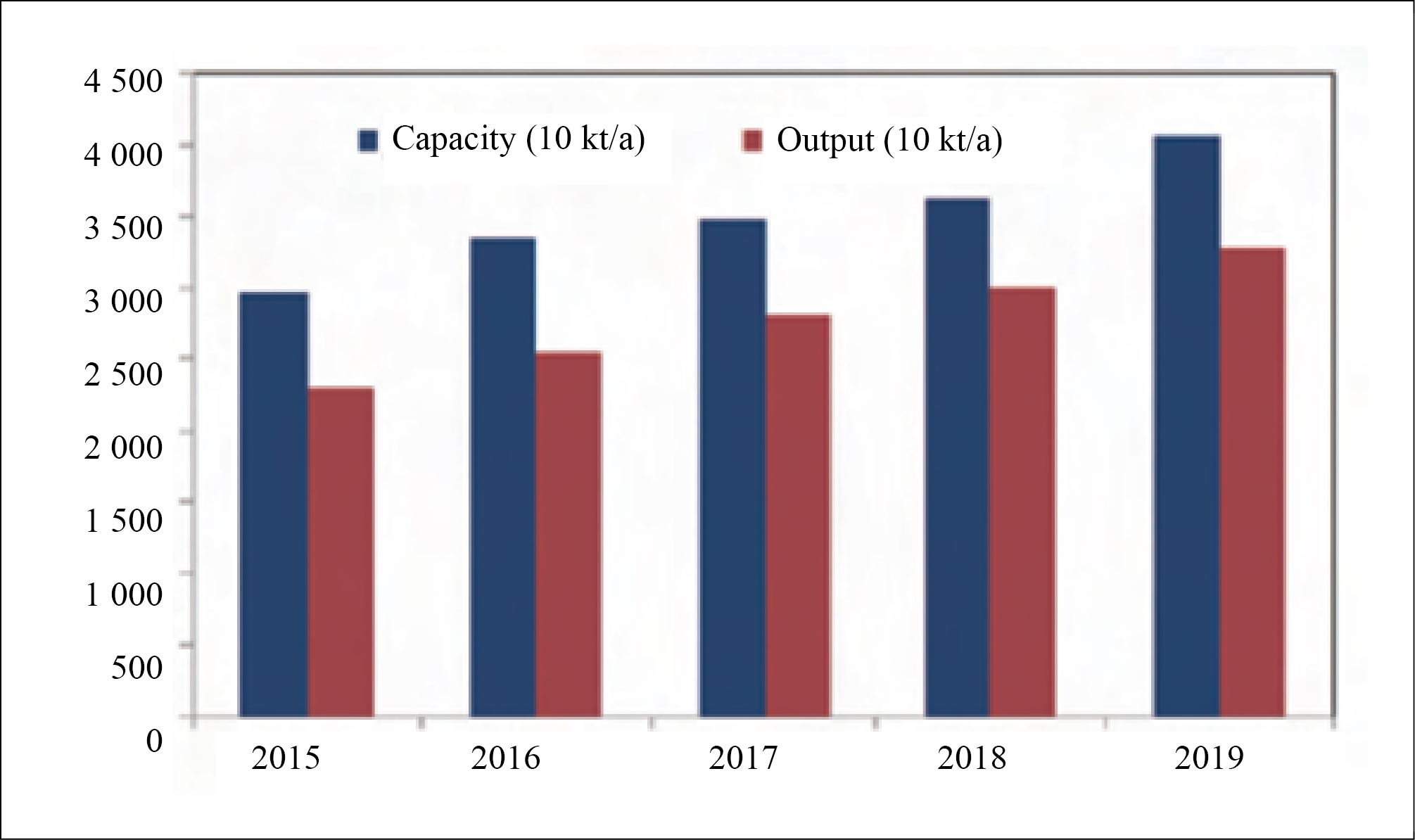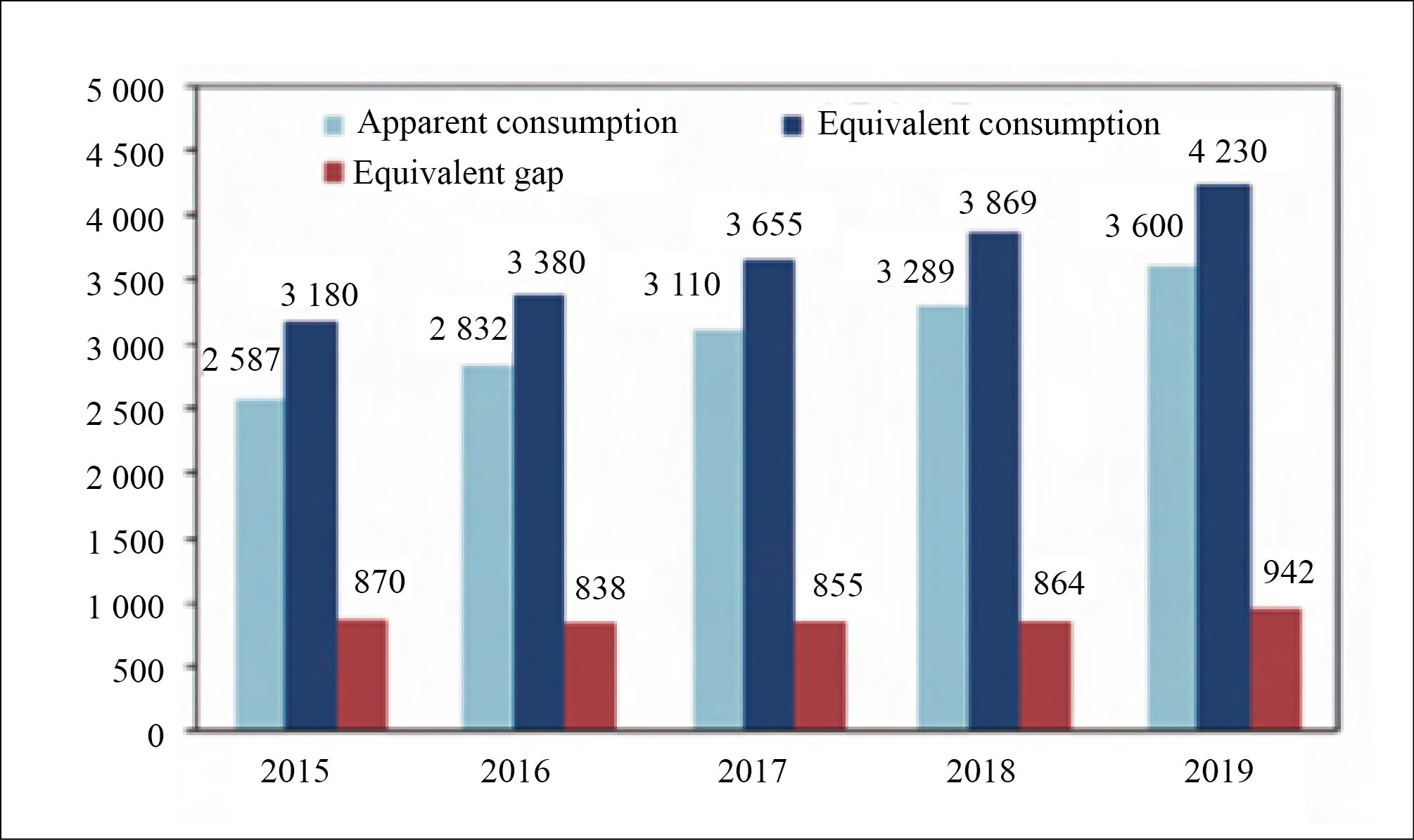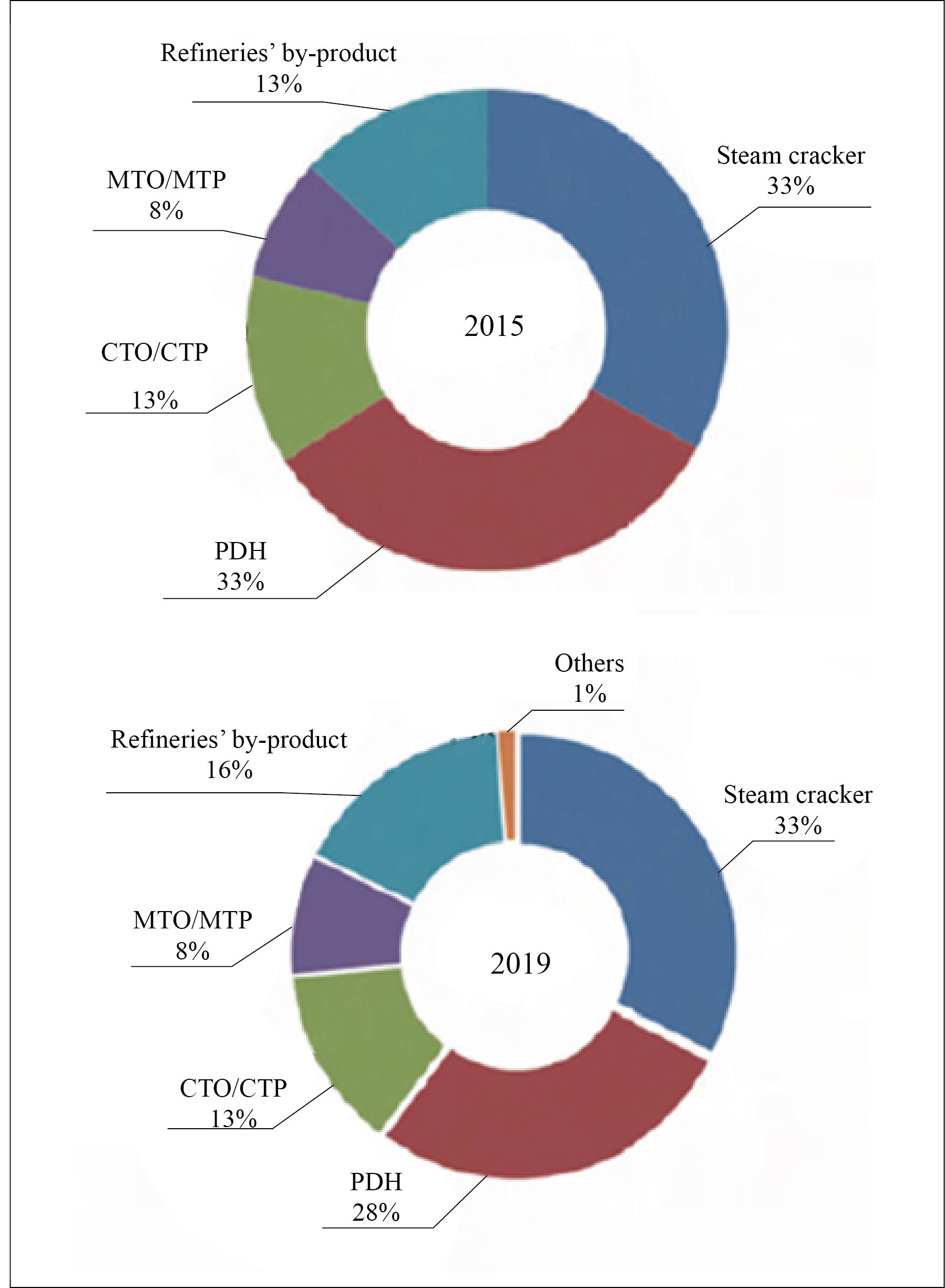By Qi Zhiqiang, Zhang Wenjun, Li Yujing, CPCIF
Current situation of domestic PDH market
1. Supply-demand fundamentals
China’s propylene capacity and output rose rapidly from 29 590 kt/a and 23 100 kt/a to 40 610 kt/a and 32 880 kt/a, respectively during 2015-2019, posting an average annual growth rate of 8.2% and 9.2%, as shown in Figure 1. The major reason behind the intensive capacity release lies in the rapid development of new feedstock routes, such as coal/methanol-to-olefin (CTO/MTO) and propane dehydrogenation (PDH) process since 2010. In 2019 alone, domestic propylene capacity surged by 4 410 kt/a, of which, 70% were contributed by non-conventional production routes, including PDH/mixed alkane dehydrogenation and CTO/MTO.

Figure 1 China’s propylene production in 2015-2019
The fast increasing propylene demand has further widened the supply-demand gap. In 2015-2019, domestic propylene consumption kept rising, with the average annual growth rate at 10.2% and 7.8%, respectively for apparent propylene consumption and equivalent consumption. Export orders for polypropylene (PP), the substitute of virgin materials for recycled materials and the explosive growth in the e-commerce industry, such as express deliveries and take-out services shored up China’s apparent propylene consumption to around 36 million tons in 2019 and equivalent consumption to 42.3 million tons, up by 9.4% and 9.3% year on year respectively. In 2019, the supply gap of propylene equivalents broadened to 9.42 million tons. Figure 2 shows changes in China’s propylene consumption during 2015-2019.

Figure 2 China’s propylene consumption in 2015-2019
The traditional naphtha route, by-product propylene at refineries and co-product propylene from steam crackers remains the major propylene production method in China. But diversification is still the development trend, featured by the rapid development of CTO/MTO and PDH routes.

Figure 3 Distribution of China propylene production methods
The low investment threshold, short construction cycle and competitive production costs lead to booming PDH process. The proportion of PDH/mixed alkane dehydrogenation has risen to 16.5%, while that of the conventional propylene production routes has dropped to 60.2%. In 2019, PDH contributed to an additional 1 500 kt/a propylene capacity in China, accounting for 34.0% of the total capacity additions; CTO/MTO took up 34.2%, with 1 510 kt/a new propylene capacities; catalytic cracking and steam cracking occupied 24.3%, with 1 070 kt/a new propylene capacities. China’s PDH capacity is expected to surpass refineries’ catalytic cracking propylene capacity by 2025.
2. PDH projects progression
China’s first PDH unit was built up in October 2013 at Tianjin Bohai Petrochemical, adopting Lummus Catofin dehydrogenation technology, with 600 kt/a of capacity. The year 2014 was one of the peak periods for PDH capacities’ start-up in China, with three units at Ningbo Haiyue, Zhejiang Satellite and Shaoxing Sanyuan put into operation, leading to capacity additions of 1 500 kt/a, which brought China’s total PDH capacity to 2 100 kt/a. Another three units launched production in 2016 amid ample margins. Lower oil prices dragged down propylene prices to troughs and no PDH units were started up in 2018 as a result. In 2019, Zhejiang Satellite’s 450 kt/a PDH unit and Dongguan Ground Resources’ 600 kt/a PDH unit came on stream. By the end of 2019, 10 PDH projects and six mixed alkane dehydrogenation projects were put into operation, with capacities at 6 110 kt/a and 930 kt/a, respectively, which combined to contribute 17.3% to total domestic propylene capacity. Details are shown in Table 1.
Table 1 PDH projects (including mixed alkane dehydrogenation) already started up in China by 2019
Process | Company | Location | Capacity (kt/a) | Technology | Start-up time |
PDH | Tianjin Bohua Petrochemical | Binhai, Tianjin | 600 | Lummus Catofin | 2013 |
Shaoxing Sanyuan Petrochemical | Shaoxing, Zhejiang | 450 | UOP C3 Oleflex | 2014 | |
Satellite Petrochemical | Pinghu, Zhejiang | 900 | UOP C3 Oleflex | 2014 | |
Ningbo Haiyue New Materials | Ningbo, Zhejiang | 600 | Lummus Catofin | 2014 | |
Oriental Energy (Zhangjiagang) New Materials | Zhangjiagang | 600 | UOP C3 Oleflex | 2015 | |
Wanhua Chemical | Yantai, Shandong | 750 | UOP C3 Oleflex | 2015 | |
Oriental Energy (Ningbo) New Materials | Ningbo, Zhejiang | 660 | UOP C3 Oleflex | 2016 | |
Hebei Haiwei Group | Hengshui, Hebei | 500 | Lummus Catofin | 2016 | |
Satellite Petrochemical | Pinghu, Zhejiang | 450 | UOP C3 Oleflex | 2019 | |
Ground Resources | Dongguan, Guangdong | 600 | Lummus Catofin | 2019 | |
Sub-total | 6 110 | ||||
Mixed alkane dehydrogenation | Chambroad Petrochemicals | Binzhou, Shandong | 120 | UOP C3/C4 Oleflex | 2015 |
Shandong Shenchi | Dongying, Shandong | 160 | Lummus Catofin | 2015 | |
Qixiang Tengda | Zibo, Shandong | 100 | UOP C3/C4 Oleflex | 2016 | |
Dongming Petrochemical | Dongming, Shandong | 120 | UOP C3/C4 Oleflex | 2017 | |
Hengli Petrochemical | Dalian, Liaoning | 300 | Lummus Catofin | 2019 | |
Yanchang Petroleum | Xi’an, Shaanxi | 130 | UOP C3/C4 Oleflex | 2019 | |
Sub-total | 930 | ||||
Total | 7 040 |
Sound profitability will set off a new round of investment boom in the PDH industry. Fujian Meide Petrochemical’s phase I project, Zhejiang Petrochemical’s PDH unit and Oriental Energy (Ningbo)’s PDH project are expected to start up in 2020. At present, 12 PDH projects, with capacities totalling 7 260 kt/a are under construction in China, including Tianhong Chemical’s PDH project. Sinochem C3 and downstream high-performance materials phase I project, Zibo Haiyi Fine Chemical’s C3 comprehensive utilization project, Formosa (Ningbo)’s PDH project and Guangxi Huayi New Materials’ propylene and downstream deep-processing integration project, which will come on line in 2020-2024. Before 2025, over 20 PDH projects are in the preliminary survey and research phase.
Some thoughts on market development
1. Supply-demand pattern likely to undergo fundamental changes
The COVID-19 outbreak and plummeted crude oil prices have crippled propylene demand. The growth rate of domestic propylene demand is poised to fall sharply in 2020. If the pandemic is effectively taken under control globally, the growth rate of domestic propylene equivalent consumption is expected to slow down to around 4.0% in 2020, with the total consumption volume at around 44 million tons. Otherwise, the growth rate of domestic propylene equivalent consumption may drop to around 2.0% or even into the negative territory. Infrastructure construction and domestic consumption will be the major growth driver of propylene demand.
Domestic propylene capacity, output and equivalent consumption are expected to reach 46 000 kt/a, 36 800 kt/a and 44 000 kt/a, respectively in 2020, which will intensify market competitions. The expansion of domestic propylene capacity will narrow the supply gap of propylene equivalent but some derivatives, including PP specialties and elastomers still need importing.
2. Concerns linger in stable and reliable propane supply
Increasing oil and gas exploration has been boosting world propane production to 171 670 kt in 2019, up by 4.76 million tons year on year. The Middle East and North America are major propane producing regions, accounting for 59.9% of world propane supply altogether. North America is the major growth driver of world propane supply, fueled by the US’ shale gas development. On the demand side, Northeast Asia is the major driving force of world propane consumption. The growth rate of propane consumption in Far East was up to 9% in 2015-2019.
China’s propane demand has been on a fast growth track, with a demand gap of 31 540 kt by 2019. Lacking domestically made products, China needs to import a large amount of propane to meet the rising demand from its surging domestic PDH capacities and the start-up of steam crackers, using propane and butane as feedstock. China imported 14.9 million tons of propane in 2019, accounting for 67.58% of total propane supply, reflecting its high reliance rate of propane imports.
3. Enormous market potential of PDH by-product hydrogen
By-product hydrogen boasts such advantages as high quality, vast potential and convenient supply. Take hydrogen produced during the PDH process for example, crude hydrogen can reach a purity of as high as 99.8% and can be used as stable hydrogen source for fuel cell after purification at low costs. The light hydrocarbon resource utilization projects that are already built, under construction and planned are concentrated in costal port areas of east and south China and can radiate fuel cell load centers, thereby reducing the hydrogen transportation costs.
However, most by-product hydrogen of the existing PDH units are burned as fuel gas. How to utilize the by-product hydrogen efficiently is a problem that needs considering urgently. By 2019, 10 PDH projects had started up in China, with capacities totalling 6 110 kt/a, yielding by-product hydrogen of 250 kt/a. Objectively speaking, the development of hydrogen energy also significantly improves the economy and enhances the development of PDH.